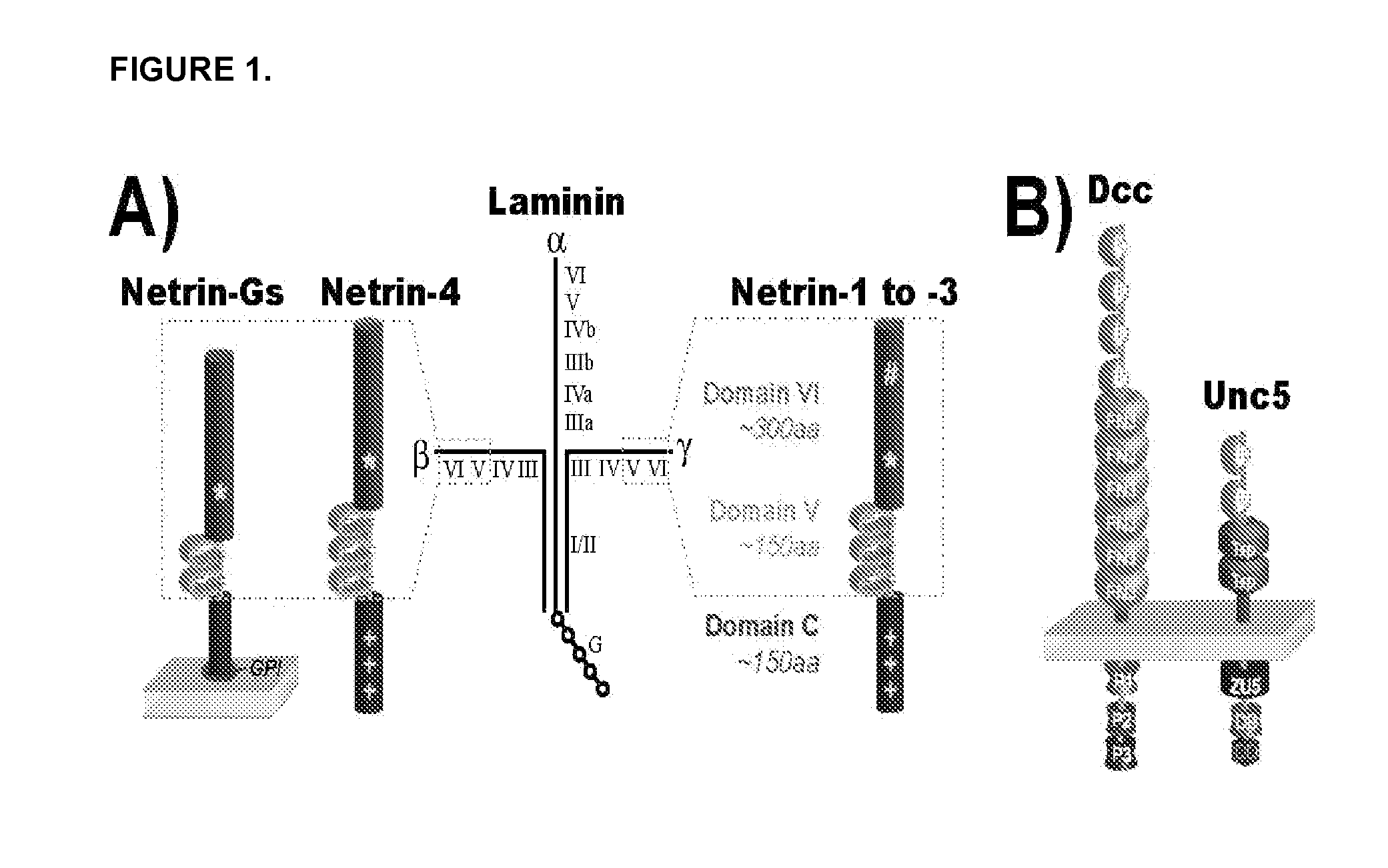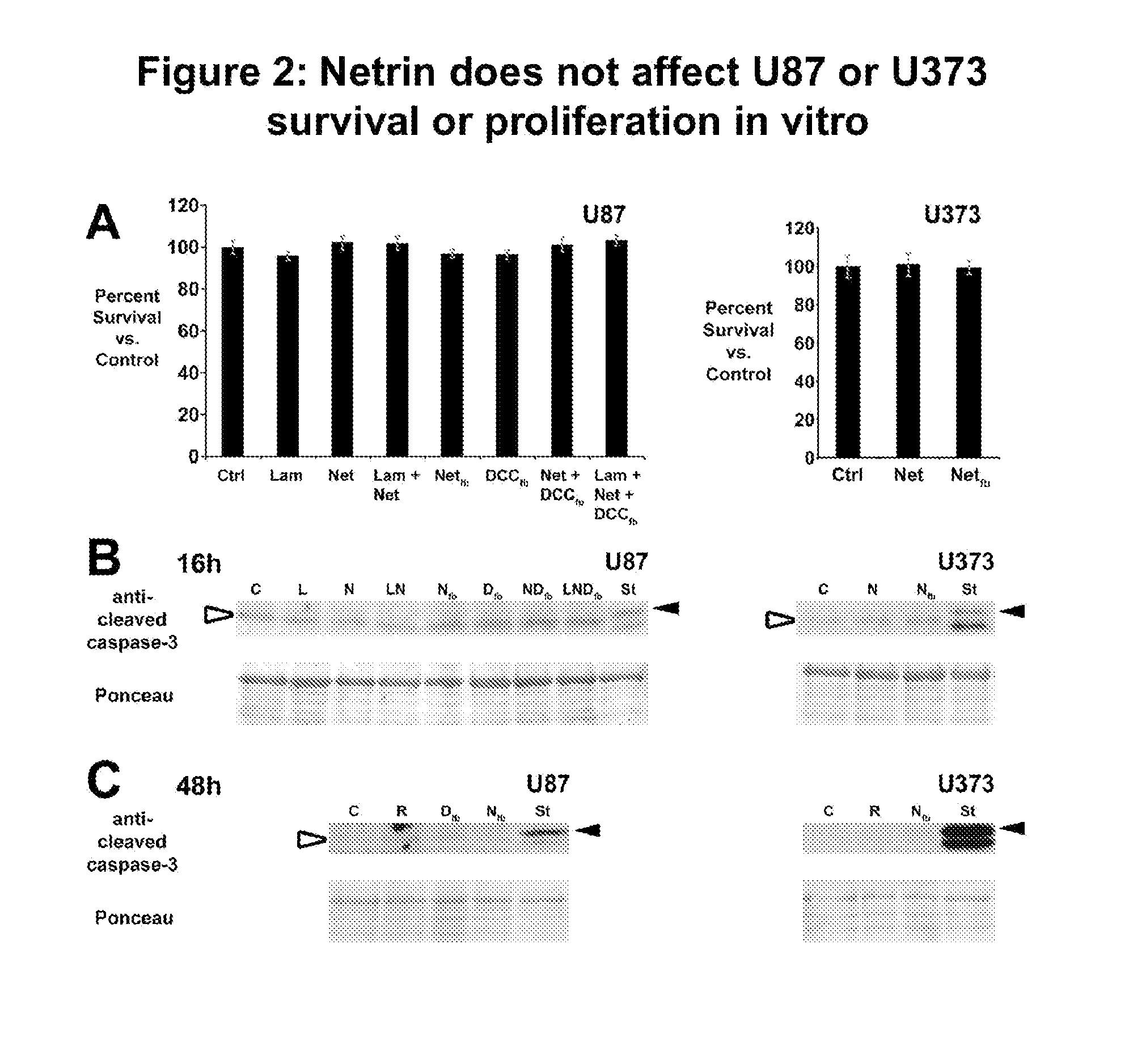Novel netrin derivatives and uses thereof
a netrin and derivative technology, applied in the direction of sugar derivatives, growth factors/regulators, animal/human proteins, etc., can solve the problem that tumor cells escape surgical removal by migrating away, and achieve the effect of reducing the size of the netrin-1 peptide, promoting migration, and inhibiting the migration of human glioblastoma cells
- Summary
- Abstract
- Description
- Claims
- Application Information
AI Technical Summary
Benefits of technology
Problems solved by technology
Method used
Image
Examples
example 1
Glioblastoma Cells Express Netrin and Netrin Receptors
[0096]To determine if netrins regulate glioblastoma cell migration, we first characterized netrin and netrin receptor expression in human astrocytoma cell lines U87. U343, and U373, and in cultures of astrocytes isolated from newborn rat cortex (FIG. 3A). Western blot analysis using an antibody that binds netrin-1 and netrin-3 (Manitt. C., et al., 2001, J. Neurosci. 21:3911-3922) detected a ˜75 kDa band corresponding to full length netrin in conditioned medium collected from all cells tested. The DCCIN antibody detected a ˜185 kDa band, corresponding to DCC in astrocyte and U87 cell lysates. In contrast, DCC was not detected in lysates of U343 or U373 cells. The DCC homologue neogenin was expressed by astrocytes and all glioblastoma cell lysates. RT-PCR (FIG. 3B) revealed dcc expression by U87 cells but not U343 or U373 cells, and neogenin and unc5 homologue expression by all three cell types. U87 cells express only unc5b. U343 c...
example 2
Netrins Inhibit Human Glioblastoma Cell Migration In Vitro
[0098]We have obtained evidence that netrins can function as autocrine factors that inhibit cell migration. Human glioblastoma cell lines (U87, U373) express netrin receptors and either netrin-1 or netrin-3 (FIG. 3). We routinely use transfilter microchemotaxis assays (FIG. 3C) to assess the rate of cell migration as described (Jarjour. A. A., et al., 2003, J. Neurosci. 23:3735-3744). Cells are plated on the upper side of a polycarbonate transwell culture inserts (6.5 mm diameter with 8 μm pore size. Corning) and allowed to migrate. Cells migrating into a pore are challenged with either an increasing gradient of a cue placed in the bottom compartment only, decreasing gradients of a cue place in the top only, or a uniform concentration of a cue placed in both the bottom and the top. The spontaneous rate of cell migration can be measured by assessing the number of cells that migrate in the absence of an added cue. Following mig...
example 3
Autocrine Netrin-1 Inhibits U87 and U373 Cell Motility
[0099]U87 cells, which express DCC, migrate substantially more slowly than either U343 or U373 cells, which do not express DCC (FIG. 3C). We hypothesized that netrin and DCC expressed by U87 cells might exert a kinetic influence on the rate of cell movement, independent of netrin's influence on directional migration. We therefore tested the effect of blocking DCC and netrin function on the spontaneous rate of U87 cell migration. Addition of netrin function-blocking antibody (NetFB) to both the top and bottom compartments, thereby disrupting autocrine netrin function, resulted in a greater than 25 fold increase in spontaneous migration across the filter relative to the number of cells migrating in either medium alone (Control), or in the presence of a control IgG (FIG. 3D). In contrast, the rate of spontaneous migration was not affected by addition of DCC function-blocking antibody (DCCFB).
PUM
| Property | Measurement | Unit |
|---|---|---|
| Time | aaaaa | aaaaa |
| Time | aaaaa | aaaaa |
| Time | aaaaa | aaaaa |
Abstract
Description
Claims
Application Information
 Login to View More
Login to View More - R&D
- Intellectual Property
- Life Sciences
- Materials
- Tech Scout
- Unparalleled Data Quality
- Higher Quality Content
- 60% Fewer Hallucinations
Browse by: Latest US Patents, China's latest patents, Technical Efficacy Thesaurus, Application Domain, Technology Topic, Popular Technical Reports.
© 2025 PatSnap. All rights reserved.Legal|Privacy policy|Modern Slavery Act Transparency Statement|Sitemap|About US| Contact US: help@patsnap.com



